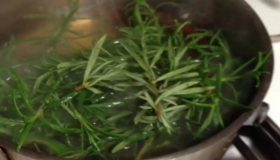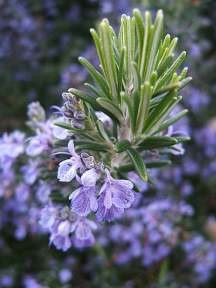Rosemary
Scientific Name: Rosmarinus officinalis
Climate: Warm, temperate, cold
Plant Description: Rosemary is a woody, evergreen, highly branched shrub that can grow to 2 meters in height. The young stems are covered with a kind of fuzz that disappears as they grow, the old stems become reddish and with fissured bark.
The small and very abundant leaves are linear. They are opposite,whole, with the edges down and dark green on the top, and below they are whitish and are covered with delicate, soft and smooth hairs. In the joint area of the leaf with the stem corsages are born. They are axillary, aromatic and melliferous flowers. They are small, about 5 mm long. Its corolla bilabiada is of a single piece. It is pale blue, pink or white, with a green or reddish calyx.1
Native to the Mediterranean region.
Cultivation: Plant in direct sun. It prefers sandy, alkaline, and loose soils with good drainage. It adapts very well to poor soils. Rosemary is quite resistant to drought. They thrive in hot and humid environments and do not withstand extremely cold temperatures. If you live in places with cold or frost at night it is better to grow it in containers. Thus it is possible to move the plant freely.
It is grown at any time of the year. It is easy to propagate by obtaining cuttings from an existing plant by cutting new branches with shoots 10 to 15 cm long, removing a few leaves from the underside, and planting them in the seedbeds where the soil should be kept slightly moist until the plant starts developing roots. During this time keep the temperature between 15 ° C to 21 ° C. It is transferred to the final place 60 days after planting. The harvest occurs 4 months later.
Rosemary needs little water. Too much water can cause root rot. Sometimes it can be difficult to determine when a rosemary plant needs water because its needles do not wilt like broad leaves do. On average, water the rosemary every 1 to 2 weeks, depending on the size of the plant and weather conditions. Allow the plants to dry completely between each watering.
Rosemary has a tendency to flower outside of its normal season. As rosemary is evergreen it can be harvested throughout the year.
Rosemary rarely needs fertilizer. But if growth is slow or the plant appears stunted or pale yellow, put natural compost once in early spring before new growth appears.
Pruning rosemary will help make a bushier plant as pruning stimulates its growth. Pruning overly large plants reduces the incidence of disease and improves air circulation within plants.2
 Uses: It can be prepared as a complete dry herb or dry powder extract, while teas and liquid extracts are made from fresh or dried leaves. The leaves are used to flavor various foods, used in soups, in stews with chicken, or sheep. It can even be used in baking.
Uses: It can be prepared as a complete dry herb or dry powder extract, while teas and liquid extracts are made from fresh or dried leaves. The leaves are used to flavor various foods, used in soups, in stews with chicken, or sheep. It can even be used in baking.
Rosemary is rich in antioxidants, calcium, iron, and vitamin B6. That is why rosemary has medicinal properties: it is anti-inflammatory; improves digestion; helps in respiratory problems; helps hair growth in bald people; studies confirm that it can slow the growth of cancerous tumors.3
Pests and Diseases: Rosemary is quite resistant to pests. Those that affect him are the following:
Shoot and stem dry fungi: attack woody stems. This disease is characterized by the formation of cankers, some wounds appear as depressed and dark areas, which strangle the area and block the supply of nutrients. The first symptoms appear on leaves and correspond with brown or dark spots. The cause is too much moisture. To prevent or to help the plant: move it to a sunnier place, water little and only in the morning, prune to reduce the number of foliage, and remove contaminated material. In order to reduce the damage, improvements can be made to the soil, such as: interspersing to aerate the ground; application of fertilizers (organic animal material, compost without nitrogen) to the soil; can be covered with mulches based on vegetable crushing (mulch).4
Rhizoctonia spp. fungus - root rot appears at the level of the neck of the plant. The attacked tissues appear discolored and subsequently will rot. You can only prevent not treat. It mostly attacks young plants after transplanting. To avoid the disease it is better to transplant by burying only the root part of the plant, do not fertilize too much in this period; do not transplant when it is hot outside (it is better to do it early morning or in the evening).
Red spiders, mealybugs, whiteflies - in order to prevent damage created by these pests create the environment to invite other insects that are not harmful to our plants but feed on them, such as ladybugs.
There are ways to fight against these: Rue Pure - soak ¼ kg of minced rue leaves in 5 liters of water for 7 to 10 days. Shake the preparation once a day to homogenize the mixture. When ready, filter and dilute the preparation in the water in a ratio of 1/5. It can be used for a few weeks. Can be stored in a cool and dark place, including the fridge.
Another preparation against the pests: garlic, 2 cayenne chili and half an onion. Grind all the ingredients, and then soak them in 1 liter of water for 2 days. Mix it from time to time so that all the properties of the ingredients are well dissolved. Strain the solution and then dilute it in 3 liters of water. It must be applied to the plant on the underside of the leaves, which is the place where red spiders are found.
Mealybugs - can be treated with neem oil or potassium soap.
Whiteflies - can be treated using cardboard and glue traps hung around plants; also use neem oil and potassium soap.
References:
- Calyx is the base and protective cone of the flower. Protects the flower and its reproductive organs.
- https://agrilifeextension.tamu.edu/browse/featured-solutions/gardening-landscaping/rosemary/
- https://pubmed.ncbi.nlm.nih.gov/17827696/
- http://www.massogarden.com/es/plagas-y-enfermedades-es/hongos-de-seca-de-brotes-y-tallos
En español: Romero

